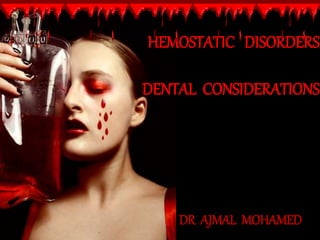This document summarizes various hemostatic disorders including those arising from vessel wall, platelet, and coagulation system abnormalities. It describes several inherited and acquired conditions that can cause bleeding disorders like hemophilia A, von Willebrand disease, and liver disease. Diagnostic tests for evaluating hemostasis are outlined including bleeding time, platelet count, prothrombin time, and activated partial thromboplastin time. Treatment approaches for different disorders are also mentioned.












































































































